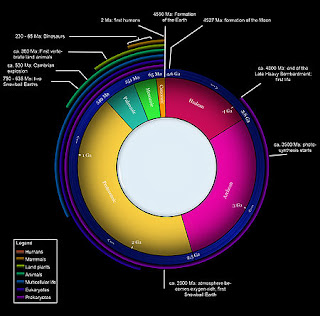The Earth's Story: A Journey through the Geological Time Scale:
The Earth has a remarkable history that spans billions of years. To make sense of this vast expanse of time, scientists have devised the Geological Time Scale.
This scale allows us to understand and organize the Earth's history into distinct periods, epochs, and eras.
In this blog post, we will take a captivating journey through the Geological Time Scale, exploring the major divisions and significant events that have shaped our planet over millions of years.
 The Basics of the Geological Time Scale: The Geological Time Scale is a framework that divides the Earth's history into eons, eras, periods, epochs, and ages. It provides a chronological record of geological and biological events, allowing us to study the progression and evolution of life on Earth. The scale is based on key geological and paleontological events, such as the appearance and extinction of certain species, major climate shifts, and geological processes.
The Basics of the Geological Time Scale: The Geological Time Scale is a framework that divides the Earth's history into eons, eras, periods, epochs, and ages. It provides a chronological record of geological and biological events, allowing us to study the progression and evolution of life on Earth. The scale is based on key geological and paleontological events, such as the appearance and extinction of certain species, major climate shifts, and geological processes.Eons and Eras: The largest divisions of the Geological Time Scale are eons and eras. The current eon, known as the Phanerozoic Eon, began approximately 541 million years ago and is further divided into three eras: the Palaeozoic Era, the Mesozoic Era, and the Cenozoic Era. Each era represents a significant period in Earth's history, characterized by distinct geological and biological events.

Periods and Epochs: Within each era, the Geological Time Scale is further divided into periods and epochs. Periods represent substantial intervals of time, while epochs are smaller subdivisions within periods. For example, the Palaeozoic Era consists of periods such as the Cambrian, Devonian, and Permian, which are further divided into epochs such as the Silurian and Carboniferous.
Significant Events and Life Forms: The Geological Time Scale is marked by numerous significant events and the evolution of life forms. For instance, the Cambrian Period witnessed the rapid diversification of marine life, known as the Cambrian Explosion. The Mesozoic Era is famous for the reign of dinosaurs, as well as the mass extinction event that ended their dominance. The Cenozoic Era is characterized by the rise of mammals, including the evolution of humans.
Geological Processes and Earth's Transformation: The Geological Time Scale is not solely focused on life forms but also encompasses significant geological processes and changes. These include the formation and breakup of supercontinents, volcanic activity, mountain building, and major climatic shifts. For instance, the breakup of the supercontinent Pangaea during the Mesozoic Era led to the formation of the modern continents and oceans.
The Geological Time Scale provides us with a fascinating glimpse into the Earth's ancient past and the evolution of life on our planet. From the earliest organisms in the Precambrian to the rise and fall of mighty dinosaurs, each division of the time scale unveils a unique chapter in Earth's history. Exploring the Geological Time Scale allows us to appreciate the immense timescales involved in shaping our planet and the interconnectedness of geological and biological processes. Google Search Engine
Visit Official Home Page





0 Comments